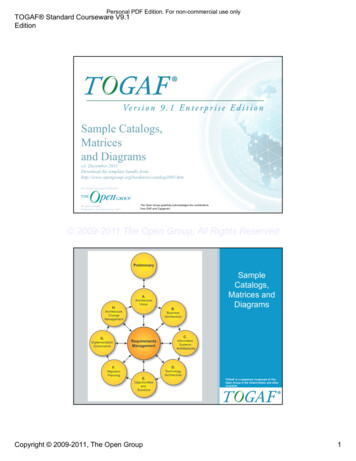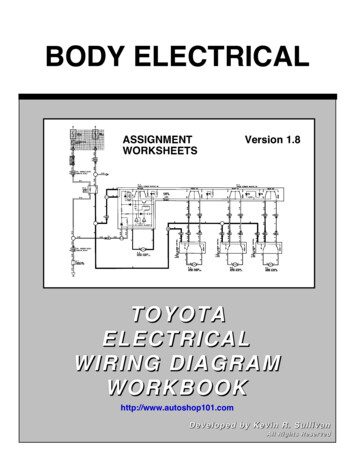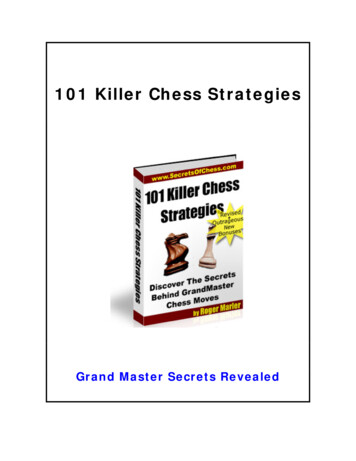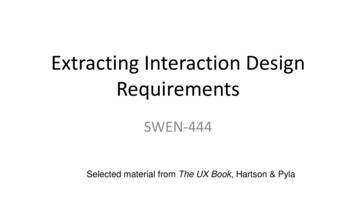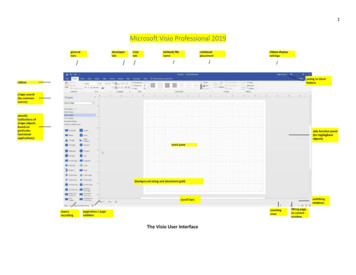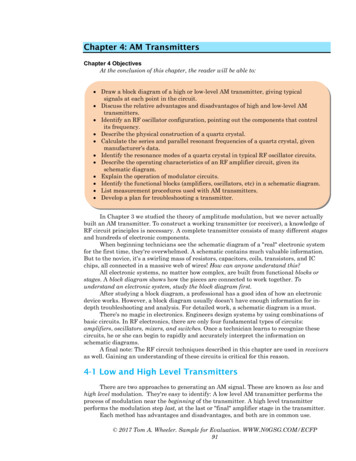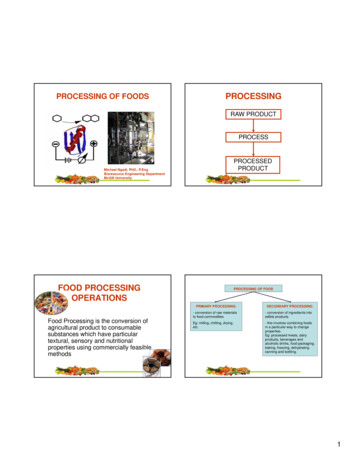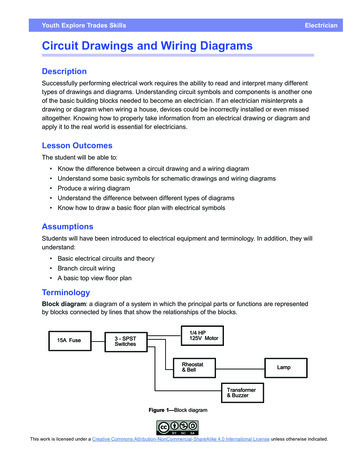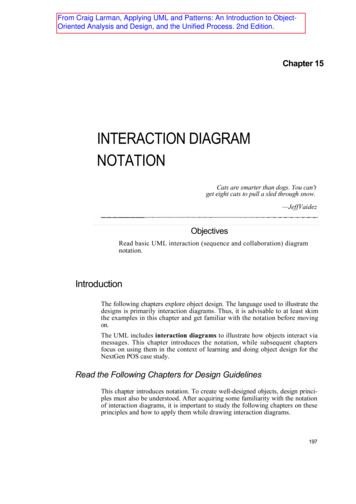
Transcription
From Craig Larman, Applying UML and Patterns: An Introduction to ObjectOriented Analysis and Design, and the Unified Process. 2nd Edition.Chapter 15INTERACTION DIAGRAMNOTATIONCats are smarter than dogs. You can'tget eight cats to pull a sled through snow.—JeffVaidezObjectivesRead basic UML interaction (sequence and collaboration) diagramnotation.IntroductionThe following chapters explore object design. The language used to illustrate thedesigns is primarily interaction diagrams. Thus, it is advisable to at least skimthe examples in this chapter and get familiar with the notation before movingon.The UML includes interaction diagrams to illustrate how objects interact viamessages. This chapter introduces the notation, while subsequent chaptersfocus on using them in the context of learning and doing object design for theNextGen POS case study.Read the Following Chapters for Design GuidelinesThis chapter introduces notation. To create well-designed objects, design principles must also be understood. After acquiring some familiarity with the notationof interaction diagrams, it is important to study the following chapters on theseprinciples and how to apply them while drawing interaction diagrams.197
15 - INTERACTION DIAGRAM NOTATION15.1Sequence and Collaboration DiagramsThe term interaction diagram, is a generalization of two more specialized UMLdiagram types; both can be used to express similar message interactions: collaboration diagrams sequence diagramsThroughout the book, both types will be used, to emphasize the flexibility inchoice.Collaboration diagrams illustrate object interactions in a graph or networkformat, in which objects can be placed anywhere on the diagram, as shown inFigure 15.1.Figure 15.1 Collaboration diagramFigure 15.2 Sequence diagram.Each type has strengths and weaknesses. When drawing diagrams to be published on pages of narrow width, collaboration diagrams have the advantage ofallowing vertical expansion for new objects; additional objects in a sequence diagrams must extend to the right, which is limiting. On the other hand, collaboration diagram examples make it harder to easily see the sequence of messages.198
EXAMPLE COLLABORATION DIAGRAM: MAKEPAYMENTEXAMPLE COLLABORATION 1JIAGRAM: MAKEfAYMENTMost prefer sequence diagrams when using a CASE tool to reverse engineersource code into an interaction diagram, as they clearly illustrate the sequenceof messages.15.2Example Collaboration Diagram: makePaymentFigure 15.3 Collaboration diagram.The collaboration diagram shown in Figure 15.3 is read as follows:1. The message makePayment is sent to an instance of a Register. The sender isnot identified.2. The Register instance sends the makePayment message to a Sale instance.3. The Sale instance creates an instance of a Payment.199
15 - INTERACTION DIAGRAM NOTATION15.3Example Sequence Diagram: makePayment: Sale: red)create(cashTendered): Paymentimplies Sale objects have aresponsibility to create PaymentsFigure 15.4 Sequence diagram.The sequence diagram shown in Figure 15.4 has the same intent as the priorcollaboration diagram.15.4Interaction Diagrams Are ValuableA common problem in object technology projects is a lack of appreciation for thevalue of doing object design via the medium of interaction diagrams. A relatedproblem is doing them in a vague way, such as showing messages to objects thatactually require much further elaboration; for example, showing the messagerunSimulation to some Simulation object, but not continuing on with the moredetailed design, as though by virtue of a well-named message the design is magically complete.Some non-trivial time and effort should be spent in the creation of interactiondiagrams, as a reflection of thinking through details of the object design. Forexample, if the length of the timeboxed iteration is two weeks, perhaps a half orfull day near the start of the iteration should be spent on their creation (and inparallel, class diagrams), before proceeding to programming. Yes, the designillustrated in the diagrams will be imperfect and is speculative, and it will bemodified during programming, but it will provide a thoughtful, cohesive, common starting point for inspiration during programming.Create interaction diagrams in pairs, not alone. The collaborative design willbe improved, and the partners will learn quickly from each other.Note that it is primarily during this step that the application of design skill isrequired, in terms of patterns, idioms, and principles. Relatively speaking, thecreation of use cases, domain models, and other artifacts is easier than the200
COMMON INTERACTION DIAGRAM NOTATIONassignment of responsibilities and the creation of well-designed interaction diagrams. This is because there is a larger number of subtle design principles and"degrees of freedom" that underlie a well-designed interaction diagram thanmost other OOA/D artifacts.The design principles necessary for the successful construction of interactiondiagrams can be codified, explained, and applied in a methodical fashion. Thisapproach to understanding and using design principles is based on patterns—structured guidelines and principles. Therefore, after introducing the syntax ofinteraction diagrams, attention (in subsequent chapters) will turn to design patterns and their application in interaction diagrams.15.5Common Interaction Diagram NotationIllustrating Classes and InstancesThe UML has adopted a simple and consistent approach to illustrate instancesvs. classifiers (see Figure 15.5): For any kind of UML element (class, actor, .), an instance uses the same graphicsymbol as the type, but the designator string is underlined.Saleclass:Saleinstances1: Salenamed instanceFigure 15.5 Class and instances.Therefore, to show an instance of a class in an interaction diagram, the regularclass box graphic symbol is used, but the name is underlined.A name can be used to uniquely identify the instance. If none is used, note that a":" precedes the class name.201
15 - INTERACTION DIAGRAM NOTATIONBasic Message Expression SyntaxThe UML has a standard syntax for message expressions:return : message(parameter : parameterType) : returnTypeType information may be excluded if obvious or unimportant. For example:spec : getProductSpect(id)spec : getProductSpect(id:ItemID)spec : Basic Collaboration Diagram NotationLinksA link is a connection path between two objects; it indicates some form of navigation and visibility between the objects is possible (see Figure 15.6). More formally, a link is an instance of an association. For example, there is a link—or pathof navigation—from a Register to a Sale, along which messages may flow, such asthe makePayment message.: Register1: makePayment(cashTendered)2: foo():Sale2.1: bar()Figure 15.6 Link lines.link lineNote that multiple messages, and messages both ways, can flow along thesame single link.MessagesEach message between objects is represented with a message expression andsmall arrow indicating the direction of the message. Many messages may flow202
BASIC COLLABORATION DIAGRAM NOTATIONalong this link (Figure 15.7). A sequence number is added to show the sequentialorder of messages in the current thread of control.msg1()1: msg2()2: msg3()3: msg4(): Register:Sale3.1: msg5()all messages flow on the same linkFigure 15.7 Messages.Messages to "self" or "this"A message can be sent from an object to itself (Figure 15.8). This is illustrated bya link to itself, with messages flowing along the link.msg1(): Register1: clear()Figure 15.8 Messages to "this."Creation of InstancesAny message can be used to create an instance, but there is a convention in theUML to use a message named create for this purpose. If another (perhaps lessobvious) message name is used, the message may be annotated with a specialfeature called a UML stereotype, like so: «create».The create message may include parameters, indicating the passing of initialvalues. This indicates, for example, a constructor call with parameters in Java.203
15 - INTERACTION DIAGRAM NOTATIONFurthermore, the UML property {new} may optionally be added to the instance box tohighlight the creation.create message, with optional initializing parameters. This willnormally be interpreted as a constructor call.1: create(cashier): Register:Sale {new}«create»1: make(cashier): Register:Sale {new}if an unobvious creation message name is used, themessage may be stereotyped for clarityFigure 15.9 Instance creation.Message Number SequencingThe order of messages is illustrated with sequence numbers, as shown in Figure15.10. The numbering scheme is:1. The first message is not numbered. Thus,msg1() is unnumbered.2. The order and nesting of subsequent messages is shown with a legal numbering scheme in which nested messages have a number appended to them.Nesting is denoted by prepending the incoming message number to the outgoing message number.msg1():ClassA:ClassB1.1: msg3()not numberedlegal numberingIn Figure 15.11 a more complex case is shown.2041: msg2():ClassC
BASIC COLLABORATION DIAGRAM NOTATIONfirstsecondthirdmsg1()1: msg2();ClassA:ClassB1.1: msg3()2.1: msg5()2: msg4()fourth:ClassCfifth2.2: msg6()sixth:ClassDFigure 15.11 Complex sequence numbering.Conditional MessagesA conditional message (Figure 15.12) is shown by following a sequence numberwith a conditional clause in square brackets, similar to an iteration clause. Themessage is only sent if the clause evaluates to true.conditional message, with testmessage1(): Foo1 [ color red ] : calculate(): BarFigure 15.12 Conditional message.Mutually Exclusive Conditional PathsThe example in Figure 15.13 illustrates the sequence numbers with mutuallyexclusive conditional paths.205
15 - INTERACTION DIAGRAM NOTATIONunconditional aftereither msg2 or msg41a and 1b are mutuallyexclusive conditional paths:ClassE2: msg6()1a [test1] : msg2()msg1():ClassA:ClassB1b [not test1] : msg4():ClassD1b.1: msg5()1a.1: msg3():ClassCFigure 15.13 Mutually exclusive messages.In this case it is necessary to modify the sequence expressions with a conditionalpath letter. The first letter used is a by convention. Figure 15.13 states thateither 1a or 1b could execute after msg1. Both are sequence number 1 sinceeither could be the first internal message.Note that subsequent nested messages are still consistently prepended withtheir outer message sequence. Thus Ib. 1 is nested message within Ib.Iteration or LoopingIteration notation is shown in Figure 15.14. If the details of the iteration clauseare not important to the modeler, a simple '*' can be used.runSimulation(): Simulator1 * [i: 1.N]: num : nextInt(): Randomiteration is indicated with a * and an optionaliteration clause following the sequence numberFigure 15.14 Iteration.206
BASIC COLLABORATION DIAGRAM NOTATIONIteration Over a Collection (Multiobject)A common algorithm is to iterate over all members of a collection (such as a list ormap), sending a message to each. Often, some kind of iterator object is ultimatelyused, such as an implementation of java.util.Iterator or a C standard libraryiterator. In the UML, the term multiobject is used to denote a set ofinstances—a collection. In collaboration diagrams, this can be summarized asshown in Figure 15.15.t : getTotal(): Sale1 *: st : getSubtotal()*:SalesLineItem:SalesLineItemdouble box indicates a multiobject (collection)these two * symbols used together implyiteration over the multiobject and sending thegetSubtotal message to each memberfor example, a List object containing manySalesLineItem objectsFigure 15.15 Iteration over a multiobject.The "*" multiplicity marker at the end of the link is used to indicate that themessage is being sent to each element of the collection, rather than beingrepeatedly sent to the collection object itself.Messages to a Class ObjectMessages may be sent to a class itself, rather than an instance, to invoke class orstatic methods. A message is shown to a class box whose name is not underlined,indicating the message is being sent to a class rather than an instance (seeFigure 15.16).message to class, or astatic method callmsg1(): InstanceOfFoolist : synchronizedList( aList )java.util.Collectionsnot underlined,therefore a classFigure 15.16 Messages to a class object (static method invocation).207
15 - INTERACTION DIAGRAM NOTATIONConsequently, it is important to be consistent in underlining your instancenames when an instance is intended, otherwise messages to instances versusclasses may be incorrectly interpreted.15.7Basic Sequence Diagram NotationLinksUnlike collaboration diagrams, sequence diagrams do not show links.MessagesEach message between objects is represented with a message expression on anarrowed line between the objects (see Figure 15.17). The time ordering is organized from top to bottom.: Register: Salemsg1()msg2()msg3()msg4()msg5()Figure 15.17 Messages and focus of control with activation boxes.Focus of Control and Activation BoxesAs illustrated in Figure 15.17, sequence diagrams may also show the focus ofcontrol (that is, in a regular blocking call, the operation is on the call stack)using an activation box. The box is optional, but commonly used by UML practitioners.208
BASIC SEQUENCE DIAGRAM NOTATIONIllustrating ReturnsA sequence diagram may optionally show the return from a message as adashed open-arrowed line at the end of an activation box (see Figure 15.18).Many practitioners exclude them. Some annotate the return line to describewhat is being returned (if anything) from the message.: Register: Salemsg1()msg2()msg3()msg4()msg5()Figure 15.18 Showing returns.Messages to "self" or "this"A message can be illustrated as being sent from an object to itself by using anested activation box (see Figure 15.19).: Registermsg1()clear()Figure 15.19 Messages to "this."209
21015 -Creation of Instances: Registernote that newly createdobjects are placed at theircreation "height": SalemakePayment(cashTendered)create(cashTendered): Paymentauthorize()an object lifeline shows the extent ofthe life of the object in the diagramFigure 15.20 Instance creation and object lifelines.Object Lifelines and Object DestructionFigure 15.20 also illustrates object lifelines—the vertical dashed lines underneath the objects. These indicate the extent of the life of the object in the diagram.In some circumstances it is desirable to show explicit destruction of an object (asin C , which does not have garbage collection); the UML lifeline notationprovides a way to express this destruction (see Figure 15.21).: Salecreate(cashTendered): Payment.«destroy»Figure 15.21 Object destructionXthe «destroy» stereotypedmessage, with the largeX and short lifelineindicates explicit objectdestruction
BASIC SEQUENCE DIAGRAM NOTATIONConditional MessagesA conditional message is shown in Figure 15.22.: Foo: Barmessage1()[ color red ] calculate()Figure 15.22 A conditional message.Mutually Exclusive Conditional MessagesThe notation for this case is a kind of angled message line emerging from a common point, as illustrated in Figure 15.23.:Amessage1():B:C[ x 10 ] calculate()[ x 15 ] calculate()Figure 15.23 Mutually exclusive conditional messages.Iteration for a Single MessageIteration notation for one message is shown in Figure 15.24.: Simulator: RandomrunSimulation()* [i: 1.N]: num : nextInt()Figure 15.24 Iteration for one message.211
15 - INTERACTION DIAGRAM NOTATIONIteration of a Series of MessagesNotation to indicate iteration around a series of messages is shown in Figure15.25.Iteration Over a Collection (Multiobject)In sequence diagrams, iteration over a collection is shown in Figure 15.26.With collaboration diagrams the UML specifies a '*' multiplicity marker at theend of the role (next to the multiobject) to indicate sending a message to eachelement rather than repeatedly to the collection itself. However, the UML doesnot specify how to indicate this with sequence diagrams.Messages to Class ObjectsAs in a collaboration diagram, class or static method calls are shown by notunderlining the name of the classifier, which signifies a class object rather thanan instance (see Figure 15.27).: Simulator: RandomrunSimulation()hours : nextInt()work( hours )* [i: 1.N]eat()Figure 15.25 Iteration for a sequence of212: Programmer
BASIC SEQUENCE DIAGRAM NOTATION:SalesLineItem:SalesLineItem: Salet : getTotal()* : st : getSubtotal()Figure 15.26 Iteration over a multiobjectmessage to class, or astatic method call: Foomessage1()java.util.Collectionslist : synchronizedList( aList )not underlined,therefore a classFigure 15.27 Invoking class or static methods213
approach to understanding and using design principles is based on . patterns. Š structured guidelines and principles. Therefore, after introducing the syntax of interaction diagrams, attention (in subsequent chapters) will turn to design pat-terns and their application in interaction diagrams.
